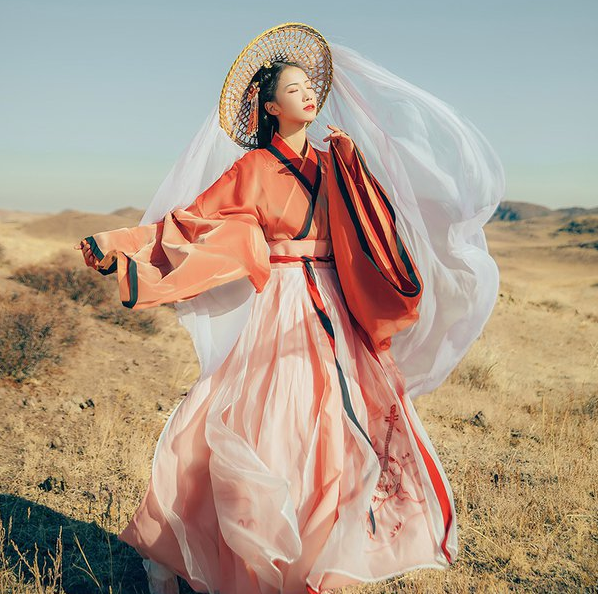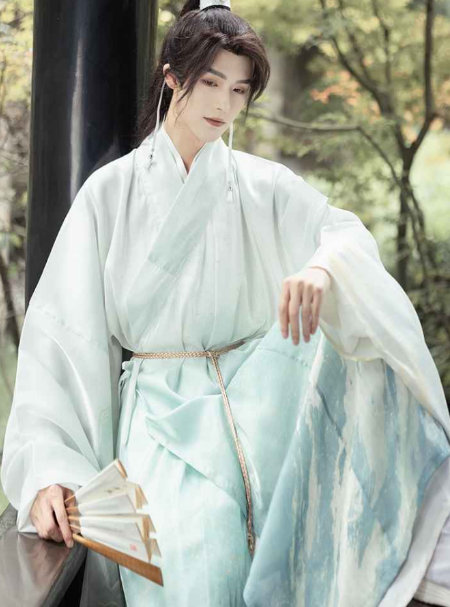Definition of Hanfu
Hanfu signifies traditional clothing worn by the Han Chinese, embodying their cultural heritage and aesthetic expression. It holds profound cultural, historical, and aesthetic significance within Chinese culture.
Cultural Significance
- Rooted in History: Hanfu dates back to ancient China, with its origins tracing to the pre-Qin period (prior to 221 BC). It reflects the cultural continuity and heritage of the Han people.
- Symbol of Identity: Hanfu serves as a symbol of ethnic identity, connecting wearers with their Chinese heritage and roots. It represents a sense of belonging and pride.
- Cultural Values: Hanfu embodies traditional Chinese cultural values such as harmony, respect for tradition, and reverence for nature. It reflects the philosophy of balance and unity.
Historical Evolution
- Dynastic Changes: Hanfu has evolved over time, with different dynasties influencing its styles and forms. Each dynasty left its mark, resulting in a rich tapestry of designs.
- Influence on East Asian Fashion: Hanfu has had a profound influence on the clothing styles of other East Asian countries, including Korea, Japan, and Vietnam, demonstrating its cultural significance beyond China’s borders.
Contemporary Revival
- Revival Movements: In recent decades, there has been a resurgence of interest in Hanfu, with individuals and organizations promoting its revival. This revival emphasizes the importance of preserving cultural heritage.
- Modern Adaptations: While Hanfu has historical roots, it has also adapted to contemporary fashion, allowing people to incorporate traditional elements into their daily attire.
Materials and Craftsmanship
- Fine Materials: Traditional Hanfu is crafted from high-quality materials such as silk and linen, showcasing the craftsmanship and attention to detail.
- Intricate Embroidery: Hanfu often features intricate embroidery and patterns that convey specific meanings and symbols.
Cultural Expression
- Festivals and Ceremonies: Hanfu is commonly worn during traditional festivals, weddings, and ceremonies, where it serves as a link to ancient traditions and customs.
- Individual Expression: Hanfu enthusiasts use it as a means of personal expression, showcasing their unique style and appreciation for Chinese culture.
Hanfu embodies a wealth of cultural meanings, making it an integral part of Chinese identity and heritage. Its revival and adaptation in modern times reflect the enduring value it holds in contemporary Chinese society.
Origin and History
The historical exploration of the origins and evolution of Hanfu reveals a fascinating journey through Chinese culture, fashion, and identity.
Ancient Origins
- Pre-Qin Period: Hanfu’s roots can be traced back to the pre-Qin period, prior to 221 BC. During this time, clothing was simple and functional, with garments made from hemp, silk, and other natural materials.
- Influences from Ancient States: Various ancient Chinese states had their clothing styles, which eventually contributed to the development of Hanfu. For example, the clothing of the Qin state influenced the design of the Shenyi (深衣), a fundamental Hanfu garment.
Dynastic Evolution
- Han Dynasty (206 BC – 220 AD): The Han Dynasty played a crucial role in shaping Hanfu. The Ruqun (襦裙) style emerged during this period, featuring a cross-collar robe with a long, flowing skirt.
- Tang Dynasty (618 – 907 AD): The Tang Dynasty saw a golden age of fashion, with intricate and colorful designs. The use of multiple layers and wide sleeves became popular.
- Ming and Qing Dynasties (1368 – 1912 AD): During the Ming and Qing Dynasties, Hanfu underwent significant changes influenced by Manchu and Mongolian cultures. The clothing style became more structured and layered.
Cultural and Symbolic Significance
- Cultural Continuity: Hanfu represents cultural continuity in China, as its styles and forms have been passed down through generations, symbolizing the enduring nature of Chinese civilization.
- Symbol of Ethnic Identity: Hanfu serves as a symbol of the Han Chinese ethnic identity, fostering a sense of belonging and cultural pride.
Modern Revival
- 20th Century: Hanfu faced challenges during the 20th century due to changes in fashion trends and political influences. It saw a decline in popularity as Western clothing became dominant.
- 21st Century: The 21st century has witnessed a resurgence of interest in Hanfu. Enthusiasts, scholars, and organizations have worked to revive and promote traditional Hanfu, leading to a revival movement.
Regional Variations
- North vs. South: China’s vast geography has led to regional variations in Hanfu styles. Northern Hanfu often includes warmer, layered garments, while Southern Hanfu tends to feature lighter, breathable fabrics.
- Ethnic Diversity: Different ethnic groups in China have their own variations of traditional clothing, reflecting the country’s multicultural heritage.
The origin and history of Hanfu provide valuable insights into the evolution of Chinese fashion and culture. Its enduring legacy continues to influence and inspire contemporary interpretations of traditional clothing.
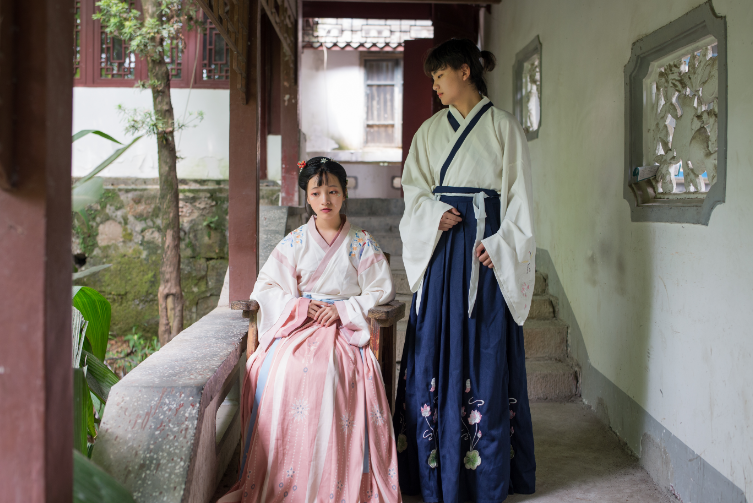
Cultural Significance
Reflection of Cultural Values
- Harmony with Nature: Hanfu often incorporates natural elements in its designs, symbolizing the Chinese value of harmony with the environment.
- Respect for Tradition: Wearing Hanfu reflects a respect for traditional Chinese culture, emphasizing the importance of preserving and passing down cultural heritage.
Symbol of Chinese Identity
- Ethnic Pride: Hanfu serves as a symbol of ethnic pride and identity, connecting wearers with their Han Chinese heritage and distinguishing them from other ethnic groups in China.
- Cultural Continuity: The continuous use of Hanfu over centuries demonstrates the enduring nature of Chinese civilization and cultural traditions.
Philosophical and Symbolic Meanings
- Yin and Yang: Hanfu often features contrasting elements, such as male and female attire, reflecting the Chinese philosophy of Yin and Yang and the balance of opposites.
- Auspicious Symbols: Many Hanfu designs incorporate auspicious symbols like dragons, phoenixes, and lotus flowers, conveying positive meanings and blessings.
Clothing for Special Occasions
- Traditional Festivals: Hanfu is commonly worn during traditional Chinese festivals, such as the Spring Festival and Mid-Autumn Festival, enhancing the festive atmosphere and cultural authenticity.
- Weddings and Ceremonies: Hanfu is often chosen as attire for weddings and ceremonies, symbolizing the importance of these life events and the cultural values associated with them.
Revival of Cultural Pride
- Revival Movement: The modern revival of Hanfu represents a resurgence of cultural pride and a desire to reconnect with China’s rich heritage.
- Cultural Exchange: Hanfu has become a means of cultural exchange, fostering understanding and appreciation of traditional Chinese values and customs.
Education and Awareness
- Promotion in Schools: Some educational institutions in China have introduced Hanfu as part of their curriculum, promoting cultural awareness and appreciation among students.
- Cultural Preservation: Efforts to promote and preserve Hanfu contribute to the safeguarding of traditional Chinese culture for future generations.
The cultural significance of Hanfu extends far beyond clothing; it represents a tangible link to China’s history, values, and traditions, enriching the cultural tapestry of the nation.
Varieties of Hanfu
An exploration of the diverse styles and forms of Hanfu reveals a rich tapestry of clothing that varies by historical period, gender, occasion, and regional influence.
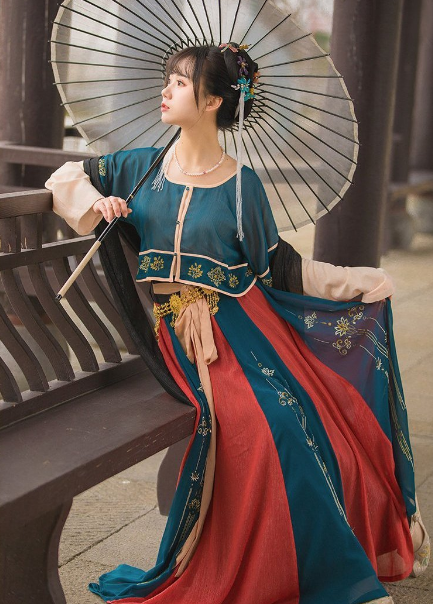
By Historical Period
- Ancient Hanfu: The earliest forms of Hanfu were characterized by simplicity, loose-fitting designs, and natural fabrics. This included garments like the Shenyi (深衣) and Daxiushan (大袖衫).
- Han and Tang Dynasty Styles: The Han and Tang dynasties introduced styles with wide sleeves and intricate embroidery, including the Ruqun (襦裙) and Daopao (道袍).
- Ming and Qing Dynasty Hanfu: The Ming and Qing dynasties saw more structured and layered Hanfu styles, such as the Ming-style Zhiduo (直裰) and the Qing-style Changshan (长衫).
Gender classification
- Male : Male Hanfu includes the Changshan (长衫), which is a long robe typically worn over pants. Accessories like the Mianfu (冕服) and Bixi (蔽膝) might also be worn.
- Female : Female Hanfu often includes the Ruqun (襦裙) or Aoqun (袄裙) for everyday wear and elaborate, multi-layered designs for special occasions.
By Occasion
- Casual : Everyday Hanfu attire is designed for comfort and practicality, making it suitable for daily wear. It may include simple Ruqun or Shan (衫) styles.
- Formal : Formal occasions call for more elaborate Hanfu, often featuring intricate embroidery, layering, and accessories like crowns and hairpins.
Regional Variations
- North vs. South: Northern Hanfu is designed for colder climates and often features layered clothing. Southern Hanfu is more lightweight and breathable due to the milder weather.
- Ethnic Diversity: Various ethnic groups in China have their own unique Hanfu styles, reflecting the country’s multicultural heritage.
Modern Adaptations
- Contemporary : In modern times, there has been a resurgence of interest in Hanfu, leading to creative adaptations that blend traditional styles with contemporary fashion trends.
- Global Influence: Hanfu’s influence has expanded beyond China, with enthusiasts around the world embracing and wearing these traditional garments.
The varieties of Hanfu showcase the versatility and adaptability of this traditional clothing, providing a visual representation of China’s rich cultural history and diversity.
Materials and Fabrics
Exploring the traditional materials and fabrics used in creating Hanfu reveals a meticulous selection process based on quality, comfort, and cultural significance.
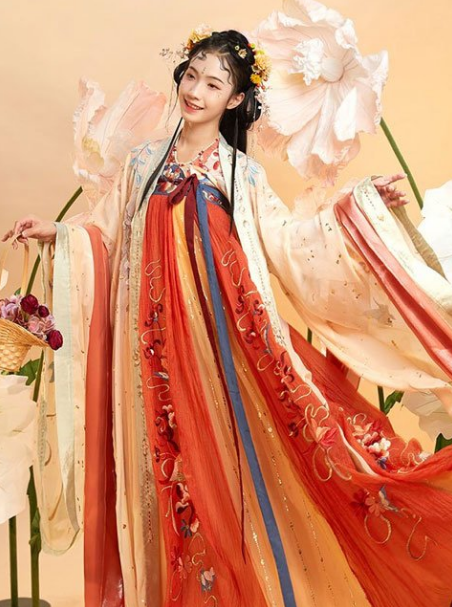
Silk: The Prized Fabric
- Silk: Silk has been a hallmark of materials for centuries. It is valued for its smooth texture, sheen, and breathability. Mulberry silk is the most coveted variety.
- Silk Quality: The quality of silk is graded by factors such as thread count (momme), with finer silk considered superior.
- Colors: Silk dyes exceptionally well, allowing for a wide range of vibrant and rich colors in Hanfu.
Hemp and Ramie: Natural Fibers
- Hemp and Ramie: These natural plant fibers have been used in Hanfu, particularly in ancient times. They are durable, breathable, and resistant to wear.
- Coolness: Hemp and ramie are known for their coolness and moisture-wicking properties, making them suitable for hot climates.
Brocade and Embroidery
- Brocade: Brocade fabrics are intricately woven with raised patterns, often featuring motifs and designs of cultural significance.
- Embroidery: Hanfu often incorporates intricate embroidery with silk threads, showcasing artistic and cultural value.
Velvet and Fur
- Velvet: Velvet is used for luxurious Hanfu, adding texture and warmth. It is often reserved for formal occasions and cold weather.
- Fur: Fur trimmings, such as fox or mink fur, have been used in provide warmth and add a touch of opulence.
Practical Considerations
- Comfort: Hanfu materials are chosen for their comfort, allowing ease of movement while maintaining elegance.
- Durability: The durability of fabrics ensures that can withstand wear over time, preserving cultural heritage.
- Cultural Significance: Certain materials, like silk and brocade, carry cultural symbolism and are chosen for their auspicious connotations.
Modern Adaptations
- Contemporary Fabrics: In modern times, Hanfu enthusiasts have explored contemporary fabrics while maintaining traditional designs, striking a balance between authenticity and comfort.
- Cost Considerations: Traditional materials like silk can be costly, leading to innovations in cost-effective alternatives that retain the essence of Hanfu.
Understanding the materials and fabrics used in Hanfu sheds light on the meticulous craftsmanship and cultural considerations that underpin the creation of these exquisite traditional garments.
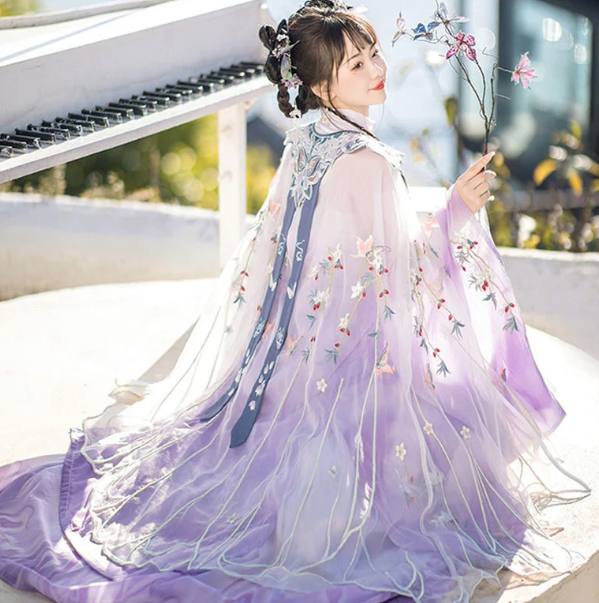
Accessories and Adornments
Exploring the accessories and ornaments that complement attire reveals a world of intricate craftsmanship, symbolism, and cultural expression.
Headwear
Hairpins and Hair Ornaments
- Hairpins (发簪): Hairpins are a common accessory for both men and women in Hanfu. They come in various designs, often featuring auspicious symbols or intricate patterns.
- Hair Ornaments (发饰): These ornaments include hair combs, hair clasps, and hair sticks. They serve both functional and decorative purposes.
Waist Belts
Yaodai (腰带)
- Functional and Ornamental: Yaodai not only helps secure garments but also adds a decorative element to the attire. They come in various materials, including silk and leather.
- Symbolism: The design of yaodai often incorporates cultural symbols, such as dragons or phoenixes, symbolizing prosperity and good fortune.
Jewelry and Accessories
Necklaces, Earrings, and Bracelets
- Jewelry: Traditional jewelry pieces like necklaces, earrings, and bracelets are worn to complement , with designs reflecting cultural themes and materials ranging from jade to gold.
- Symbolic Meanings: Many jewelry pieces carry symbolic meanings, such as longevity, wealth, and protection from negative energy.
Footwear
Traditional Shoes
- Lotus Shoes (荷叶鞋): Lotus shoes are a type of bound foot shoe historically worn by women. They are characterized by their small size and exquisite embroidery.
- Boots and Sandals: Men’s Hanfu may be paired with boots or sandals, with designs suited to various occasions and climates.
Fans and Handkerchiefs
Shan (扇) and Wen (巾)
- Fans (扇): Fans are not only practical but also serve as accessories with artistic designs. They come in folding or fixed styles, often made of materials like silk or paper.
- Handkerchiefs (巾): Handkerchiefs can be tucked into the collar or sleeve for both decorative and functional purposes.
Modern Adaptations
- Contemporary Trends: In modern times, Hanfu enthusiasts have incorporated contemporary accessories and adaptations, blending traditional styles with personal preferences.
- Customization: Many wearers choose accessories that align with their personal style and the specific occasion, showcasing the versatility of traditional attire.
Understanding the accessories and adornments in provides insights into the meticulous attention to detail and cultural symbolism that enriches the overall aesthetic and cultural significance of attire.
